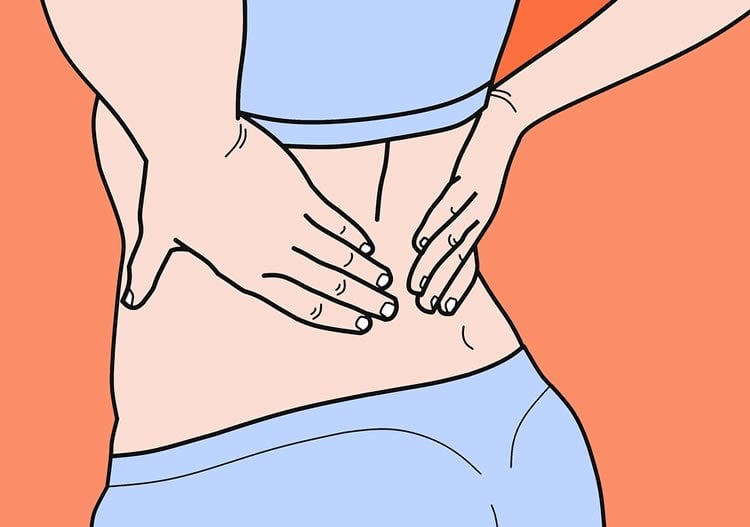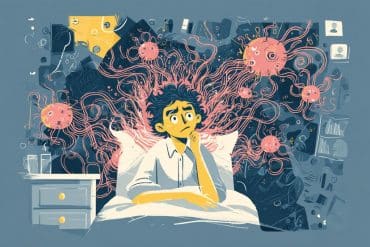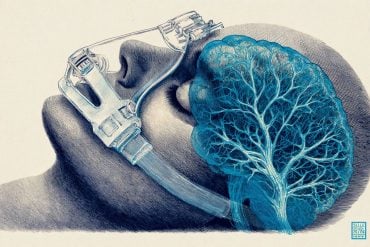Summary: A new study reveals a link between chronic sciatica and inflammation in key areas of the nervous system. Researchers say the location of the inflammation could help to determine which patients will feel relief from steroid injections to curb the pain.
Source: Mass General.
A study by Massachusetts General Hospital (MGH) investigators has found, for the first time in humans, that patients with chronic sciatica – back pain that shoots down the leg – have evidence of inflammation in key areas of the nervous system. In their paper published in the May issue of the journal Pain, the research team reports finding that average levels of a marker of neuroinflammation were elevated in both the spinal cord and the nerve roots of patients with chronic sciatica. Additionally, the study showed an association between neuroinflammation and response to anti-inflammatory steroid injections, with levels of neuroinflammation differing between those whose pain was and those whose pain was not relieved by steroid injection treatment.
“Sciatica is an extremely common pain condition and is estimated to affect around 5 percent of men and 4 percent of women in their lifetimes,” says Yi Zhang, MD, PhD, of the Center for Pain Management in the MGH Department of Anesthesia, Critical Care and Pain Management, a co-senior author of the report. “More than 5 million cases of sciatica are seen annually in the U.S., which represent a major cause of lost work days.”
Several animal studies have documented activation of the immune system – including glial cells, which function as the immune cells of the nervous system – in chronic pain, raising the possibility that blocking neuroinflammation could be a viable treatment. Recent evidence from the laboratory of co-senior author Marco Loggia, PhD, of the MGH-based Martinos Center for Biomedical Imaging, found glial cell activation in the brains of patients with chronic pain, but no prior studies have demonstrated neuroinflammation beyond the brain in humans with chronic pain. Even though a contribution of inflammation to acute pain in sciatica provides the rationale for anti-inflammatory steroid injections, evidence linking neuroinflammation with chronic sciatic pain in humans has been limited.
The current study combined both MR and PET imaging to test the hypothesis that chronic radiculopathy, a condition combining sciatica with additional lower-back-pain symptoms, would be associated with inflammatory activation in both the neuroforamina – the spaces around the spine through which nerve roots pass into the spinal cord – and within the spinal cord itself. Study participants – including 16 patients with chronic radiculopathy and 10 control volunteers – had combined MR/PET imaging with a radiopharmaceutical that binds to TSPO, a marker for neuroinflammation. MR/PET imaging focused on neuroforamina in the lumbar spine for all participants, and in a subset of 18 – 9 patients and 9 controls – images were also taken of the sections of the lower spinal cord that are connected to the nerve roots affected in sciatica.
Overall the study results indicated that, compared with those of control participants, TSPO levels in sciatica patients were higher in both the neuroforamina and the spinal cord. The sciatica-associated elevations were seen in nerve roots on the side of affected legs and in spinal cord segments known to process sensory signals from the legs. Among 9 patient participants who received steroid injections as part of their clinical care – 2 before the scanning and 7 after – only 5 experienced significant relief from the procedure, and those 5 all had results indicating higher neuroforaminal TSPO levels.

“The fact that patients with stronger TSPO elevations in the nerve roots benefited most from a local anti-inflammatory treatment makes sense,” says Loggia. “For patients who didn’t benefit from steroid injections, the source of pain and inflammation may be the spinal cord or, as shown in our previous paper, the brain itself.”
Zhang adds, “If larger studies confirm that the efficacy of steroid injections correlates with nerve root inflammation, physicians will have a way to identify which patients are most likely to benefit from the procedure. Our results also suggest that directly treating neuroinflammation in the spinal cord may help patients who don’t respond to steroid injections. Finding a way to treat spinal neuroinflammation for those patients is a goal that we are actively pursuing.”
Zhang is an assistant professor of Anæsthesia, and Loggia an assistant professor of Radiology at Harvard Medical School.
Daniel Albrecht, PhD, of the Martinos Center is lead author of the Pain paper. Additional co-authors are Shihab Ahmed, MBBS, Arissa Opalacz, Sarah Roth, Hao Deng, MMBM, Timothy Houle, PhD, Marcos Vidal Melo, MD, PhD, Lucy Chen, MD, and Jianren Mao, MD, PhD, MGH Anesthesia, Critical Care and Pain Medicine; Jacob Hooker, PhD, Martinos Center; Norman Kettner, DC, Logan University; Ronald Borra, MD, PhD, Turku University Hospital, Finland; and Julien Cohen-Adad, PhD, University of Montreal.
Funding: The study was supported by National Institutes of Health grants 1R01 NS095937-01A1, 1R21 NS087472-01A, NS082548-01A1 and 5T32 EB13180.
Source: Terri Ogan – Mass General
Publisher: Organized by NeuroscienceNews.com.
Image Source: NeuroscienceNews.com image is in the public domain.
Original Research: Abstract for “Neuroinflammation of the spinal cord and nerve roots in chronic radicular pain patients” by Daniel S. Albrecht; Shihab U. Ahmed; Norman W. Kettner; Ronald J.H. Borra; Julien Cohen-Adad; Hao Deng; Timothy T. Houle; Arissa Opalacz; Sarah A. Roth; Marcos F. Vidal Melo; Lucy Chen; Jianren Mao; Jacob M. Hooker; Marco L. Loggia; Yi Zhang in Pain. Published May 10 2018.
doi:10.1097/j.pain.0000000000001171
[cbtabs][cbtab title=”MLA”]Mass General”Neuroinflammation Seen in Spinal Cord and Nerve Roots of Patients With Chronic Sciatica.” NeuroscienceNews. NeuroscienceNews, 10 May 2018.
<https://neurosciencenews.com/sciatica-neuroinflammation-9018/>.[/cbtab][cbtab title=”APA”]Mass General(2018, May 10). Neuroinflammation Seen in Spinal Cord and Nerve Roots of Patients With Chronic Sciatica. NeuroscienceNews. Retrieved May 10, 2018 from https://neurosciencenews.com/sciatica-neuroinflammation-9018/[/cbtab][cbtab title=”Chicago”]Mass General”Neuroinflammation Seen in Spinal Cord and Nerve Roots of Patients With Chronic Sciatica.” https://neurosciencenews.com/sciatica-neuroinflammation-9018/ (accessed May 10, 2018).[/cbtab][/cbtabs]
Abstract
Neuroinflammation of the spinal cord and nerve roots in chronic radicular pain patients
Numerous preclinical studies support the role of spinal neuroimmune activation in the pathogenesis of chronic pain, and targeting glia (eg, microglia/astrocyte)- or macrophage-mediated neuroinflammatory responses effectively prevents or reverses the establishment of persistent nocifensive behaviors in laboratory animals. However, thus far, the translation of those findings into novel treatments for clinical use has been hindered by the scarcity of data supporting the role of neuroinflammation in human pain. Here, we show that patients suffering from a common chronic pain disorder (lumbar radiculopathy), compared with healthy volunteers, exhibit elevated levels of the neuroinflammation marker 18 kDa translocator protein, in both the neuroforamina (containing dorsal root ganglion and nerve roots) and spinal cord. These elevations demonstrated a pattern of spatial specificity correlating with the patients’ clinical presentation, as they were observed in the neuroforamen ipsilateral to the symptomatic leg (compared with both contralateral neuroforamen in the same patients as well as to healthy controls) and in the most caudal spinal cord segments, which are known to process sensory information from the lumbosacral nerve roots affected in these patients (compared with more superior segments). Furthermore, the neuroforaminal translocator protein signal was associated with responses to fluoroscopy-guided epidural steroid injections, supporting its role as an imaging marker of neuroinflammation, and highlighting the clinical significance of these observations. These results implicate immunoactivation at multiple levels of the nervous system as a potentially important and clinically relevant mechanism in human radicular pain, and suggest that therapies targeting immune cell activation may be beneficial for chronic pain patients.







